To create professional perfume oil blends, you'll need to master dilution ratios and precise measurements. Start with a 10% concentration by mixing 10ml essential oil with 90ml carrier oil, or adjust to 20% using 20ml essential oil with 80ml carrier oil. Use digital scales and quality droppers for accuracy, and select appropriate carrier oils like jojoba or coconut. Following these basic guidelines will open the door to mastering advanced perfume blending techniques.
Understanding Perfume Oil Dilution Ratios
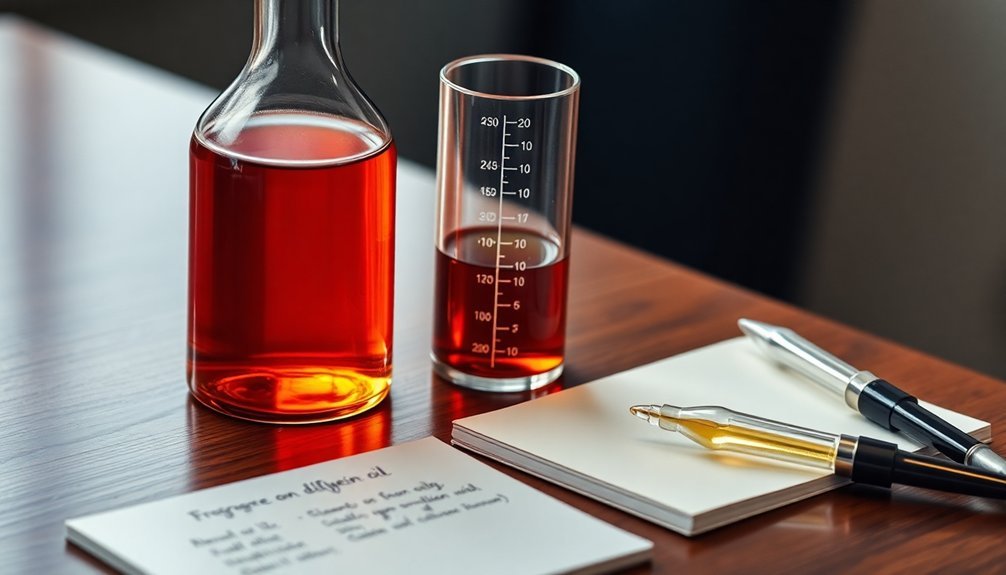
Perfume oil dilution ratios form the foundation of safe and effective fragrance creation.
When you're working with essential oil dilution, you'll encounter common concentrations of 10%, 20%, and 30%, though lower percentages are often safer for sensitive skin. For a 10% blend, you'll need 10ml of essential oil mixed with 90ml of carrier oil, while a 20% solution requires 20ml of essential oil and 80ml of carrier oil.
For maximum accuracy, it's best to weigh your ingredients rather than measure by volume, since oil densities can vary considerably.
If you're new to blending, start with a conservative 1% dilution for potent oils, or 2-3% for general topical use. You'll find that using a dilution calculator makes the process much more precise and efficient.
Essential Tools for Precise Measurements
You'll need a digital scale that measures to at least two decimal points to achieve accurate perfume oil dilutions, with the ability to tare between ingredients.
Quality droppers and graduated cylinders help maintain consistency when working with small quantities of essential oils and carriers.
Having precise measuring vessels becomes particularly important when you're working with ingredients of different densities, such as alcohol at 0.789g/cm³, where volume measurements alone won't suffice.
Digital Scale Basics
When crafting your own perfume oils, a reliable digital scale serves as your foundation for success. You'll need one that measures to at least two decimal points to guarantee proper ratios between your oils and carriers. It's crucial to choose a scale that displays both grams and ounces for maximum versatility in your formulations.
| Feature | Why It Matters | Best Practice |
|---|---|---|
| Precision | Accurate ratios | Use 0.01g minimum |
| Calibration | Consistent results | Check before each use |
| Tare function | Clean measurements | Zero between ingredients |
| Dual units | Recipe flexibility | Switch between g/oz |
Remember to weigh ingredients directly in your blending container, using the tare function between additions. This method eliminates errors that can occur with liquid volume measurements, as different oils have varying densities that affect their true quantities.
Droppers and Measuring Vessels
Three essential measuring tools form the backbone of precise perfume oil dilution: droppers, graduated cylinders, and pipettes.
You'll find these instruments indispensable for crafting consistent fragrance formulations with confidence.
Droppers excel at dispensing small quantities of essential oils with pinpoint accuracy, while graduated cylinders and pipettes display clear volume markers for precise measurements.
To maintain the integrity of your oils during measuring, opt for amber or cobalt blue glass dropper bottles that shield sensitive ingredients from light exposure.
Don't forget to pair these tools with a scale that measures to two decimal points for maximum liquid measurement precision.
Regular calibration of your measuring instruments is crucial – it guarantees your dilution calculations remain accurate and your fragrance blends maintain professional quality standards.
Basic Calculations for Oil Concentrations
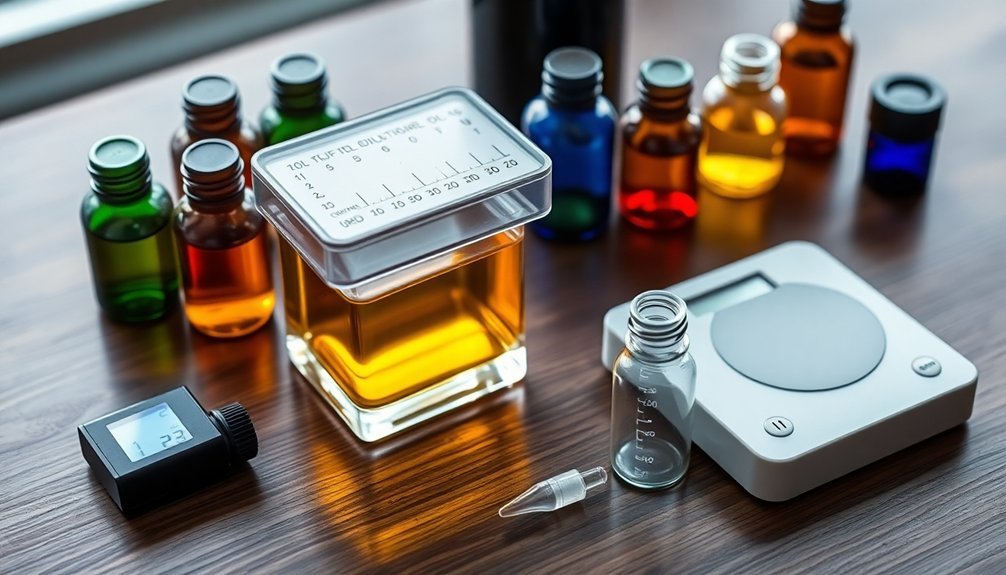
Understanding the basics of oil concentration calculations is crucial for creating safe and effective perfume blends. You'll need to master the dilution ratio formula: (Essential Oil Drops / Carrier Oil Drops) × 100. For a 2% dilution in 30ml carrier oil, use 12 drops of essential oil to maintain safe topical application levels.
| Dilution % | Essential Oil (g) | Carrier Oil (g) |
|---|---|---|
| 10% | 2.5 | 22.5 |
| 5% | 1.25 | 23.75 |
| 2% | 0.5 | 24.5 |
Always measure your oils by weight instead of volume for precise concentrations. When working with sensitive skin, stick to 1-3% dilutions to prevent irritation. Remember that different oils have varying densities, so using a scale guarantees accuracy in your final blend calculations.
Carrier Oil Selection and Properties
Building on your knowledge of dilution ratios, selecting the right carrier oil forms the foundation of your perfume blend.
You'll need to take into account how each carrier oil's unique properties affect your final fragrance. Cold-pressed and organic options, like coconut, jojoba, and sweet almond oil, offer superior quality and enhanced skin benefits.
The carrier oil you choose will influence both the scent profile and staying power of your perfume. Since carrier oils have higher viscosity than essential oils, they'll help slow down fragrance evaporation when applied to your skin.
When measuring your ingredients, remember that different carrier oils have varying densities, which directly impact your blend's total volume and weight. This understanding guarantees you'll achieve the perfect dilution for your custom perfume creation.
Fragrance Notes and Concentration Levels
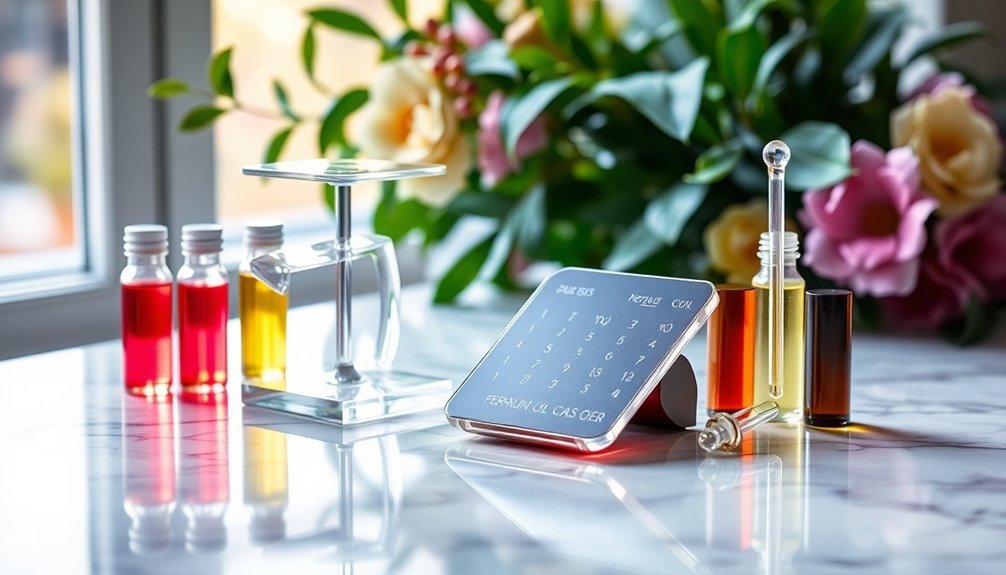
Understanding fragrance note ratios helps you create balanced perfumes, with a typical distribution of 30% top notes, 50% middle notes, and 20% base notes in your formulation.
You'll need to take into account concentration levels ranging from light cologne (2-5%) to intense Eau de Parfum (15-20%) to match your desired scent strength.
When working with essential oils, start with a 10% dilution in your carrier oil for safe application, adjusting the ratio based on your chosen concentration category.
Top-Middle-Base Note Ratios
The art of perfume creation hinges on the delicate balance between three distinct fragrance layers: top notes, middle notes, and base notes. You'll need to carefully measure each component to achieve a harmonious blend that evolves beautifully on the skin.
| Note Layer | Percentage | Common Ingredients |
|---|---|---|
| Top Notes | 20-30% | Citrus, Herbs |
| Middle Notes | 40-60% | Florals, Spices |
| Base Notes | 20-30% | Woods, Musks |
When mixing your perfume oils, start with the base notes as your foundation. Then, add the middle notes, which will form the fragrance's core character. Finally, blend in your top notes – these create that vital first impression and set the tone for your entire composition. Remember, these ratios aren't rigid rules but rather guidelines you can adjust to create your unique scent profile.
Concentration Level Guidelines
Mastering fragrance concentration levels takes your perfume creation skills beyond basic note ratios.
When you're mixing essential oils, understanding concentration percentages helps you achieve professional results. You'll want to match your target concentration to your desired fragrance type, whether it's a lighter EdT or a stronger EdP.
- Eau de Toilette (EdT): Mix 5-15% essential oils for a subtle, daytime fragrance
- Eau de Parfum (EdP): Blend 15-20% essential oils for a more pronounced scent
- Parfum: Create intense fragrances with 20-40% essential oils
- Precise measurements: Use 2.5g oils per 30ml for a 10% concentration
- Dilution medium: Choose between alcohol or carrier oils for proper diffusion
Remember to start with your chosen concentration level before layering your notes. This guarantees your final creation maintains the intended strength while allowing proper development of the scent profile.
Dilution Strength Categories
When crafting your signature scent, proper dilution strength directly affects how your fragrance notes interact and develop over time.
You'll find that different concentration levels require specific dilution ratios to achieve ideal results.
For Eau de Toilette, you'll want to aim for a 5-15% fragrance concentration, which creates a lighter, more subtle blend.
Moving up to Eau de Parfum at 15-20%, you'll notice stronger projection and better note separation.
The highest concentration, Parfum at 20-30%, delivers the most intense and long-lasting fragrance experience.
To guarantee accuracy, you'll need to maintain precise measurements.
For instance, using 2.5 grams of essential oil in a 30ml bottle creates a 10% solution.
This careful attention to dilution helps you achieve the perfect balance between top, middle, and base notes.
Step-by-Step Mixing Guidelines

Creating perfect perfume oil blends requires careful attention to measurements and ratios.
Precision and accuracy in measurements are essential for crafting exquisite perfume oil blends that delight the senses.
You'll need to start by determining your total blend volume and choosing your desired dilution strength. Whether you're aiming for a gentle 1% blend or a stronger 5% therapeutic mixture, precise calculations are vital for success.
- Calculate your blend's total volume first to guide your measurements
- Choose your dilution ratio based on skin sensitivity and intended use
- Use the dilution rate formula to determine exact essential oil drops needed
- Measure carrier oils with precision tools like droppers or scales
- Document all measurements to replicate successful blends later
Following these steps guarantees you'll create consistent, properly diluted perfume oils every time.
Remember to mix thoroughly to distribute the essential oils evenly throughout your carrier base for ideal results.
Common Dilution Standards and Formulas
You'll find that perfume oil dilution typically follows standard ratios of 1%, 2%, and 3-5%, with each serving specific purposes from gentle skin application to therapeutic use.
To achieve these ratios accurately, you can use the simple formula: Dilution Rate = (Total Essential Oil Drops / Total Carrier Oil Drops) × 100.
For practical application, creating a 2% dilution in 30 ml of carrier oil requires 12 drops of essential oil, making it easy to measure and mix your perfect blend.
Essential Oil Ratio Basics
Understanding essential oil dilution ratios serves as the foundation for creating safe and effective perfume blends.
You'll need to master basic calculations to protect your skin and achieve the desired fragrance intensity. For a 2% dilution in 30ml of carrier oil, you'll use about 12 drops of essential oil, which provides a safe starting point for most applications.
- 1% dilution works best for sensitive skin applications
- 2% dilution suits most general-purpose perfume blends
- 3-5% dilution creates stronger therapeutic formulations
- Calculate your ratio using: (Essential Oil Drops / Carrier Oil Drops) × 100
- Consider each oil's properties when creating custom blends
Calculating Perfect Dilutions
Three core formulas form the backbone of precise perfume oil dilutions, making the process methodical and reliable.
You'll find that standard ratios include 1% for sensitive skin, 2% for everyday use, and 3-5% for therapeutic applications.
To create a precise 10% blend, you'll need to combine 2.5 grams of essential oil with 22.5 grams of carrier oil or ethanol.
For a quick calculation, use this formula: Dilution Rate = (Total Essential Oil Drops / Total Carrier Oil Drops) × 100.
When working with a 30 ml carrier oil base, you'll need approximately 12 drops of essential oil to achieve a 2% dilution.
Remember to use a scale that measures to two decimal places for the most accurate results.
This precision guarantees your perfume blends are both safe and effective.
Troubleshooting Concentration Issues
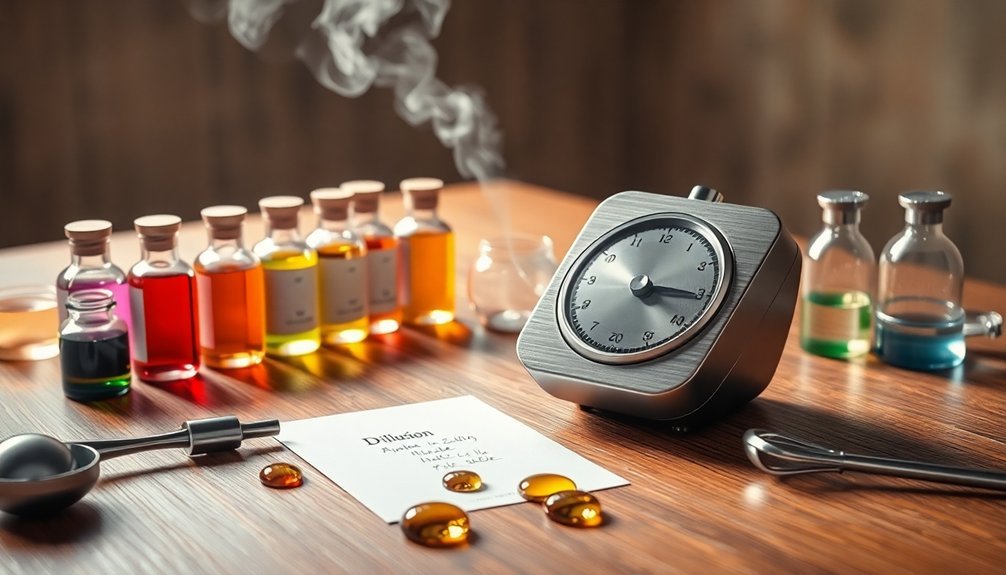
When creating perfume oil blends, concentration issues can notably impact the final fragrance's performance and appeal. You'll need to monitor the total volume carefully and maintain precise measurements using a scale with two decimal points.
If you're experiencing concentration problems, start by verifying that your blend's weight matches your target dilution ratio.
- Always double-check your calculations before making adjustments
- Keep detailed records of weights and proportions for each ingredient
- Dilute overly strong scents by adding more carrier oil or ethanol
- Reduce the amount of any overwhelming ingredients to restore balance
- Use your documented formulations to make informed adjustments
When troubleshooting, remember that small variations in measurements can notably affect your final product.
Best Practices for Professional Results
Professional perfume oil blending requires meticulous attention to detail and proven techniques to achieve superior results. You'll need to always dilute your oils using a precise scale with two decimal points to guarantee accurate measurements and consistent outcomes.
| Step | Action | Purpose |
|---|---|---|
| 1 | Create materials list | Track proportions |
| 2 | Measure with precision | Guarantee accuracy |
| 3 | Record all weights | Enable reproduction |
| 4 | Allow maturation | Evaluate scent |
Before starting your blend, prepare a detailed list of materials and their intended proportions. Begin with a 10% dilution for stronger scents, adjusting the ratio based on your specific needs. Document every measurement precisely, as this information will prove invaluable for future reproductions. Remember to let your blend mature for at least a week to fully assess the final scent profile, as notes can develop and change over time.
Advanced Blending Techniques and Tips
Mastering advanced fragrance blending requires a systematic layering approach combined with precise measurement techniques.
Precise measurements and systematic layering form the foundation of expert perfumery, allowing artisans to craft complex, refined fragrances.
You'll create sophisticated scents by starting with base notes, adding middle notes, and finishing with top notes. After blending, let it sit for at least a week to achieve ideal maturity and complexity.
- Always weigh your ingredients using a precise scale instead of counting drops
- Document every measurement and concentration ratio in your blending journal
- Use high-quality ethanol for diluting your fragrance to 10% or less
- Layer your notes systematically, allowing each layer to settle before adding the next
- Store your blends in dark glass bottles during the maturation period
This methodical approach guarantees consistency in your formulations and helps you develop a library of reproducible scents that you can perfect over time.
Frequently Asked Questions
What Is the Ratio for Mixing Fragrance Oils?
You'll need different ratios for fragrance oils: use 10% for strong scents (10ml oil/90ml carrier), 5% for regular use (5ml oil/95ml carrier), and 1% for sensitive skin (1ml oil/99ml carrier).
What Is the 30/50/20 Rule for Perfume?
You'll create balanced perfumes by following the 30/50/20 rule: use 30% top notes for initial impact, 50% middle notes for the main scent, and 20% base notes to anchor the fragrance.
What Is the Dilution Ratio for Perfume?
You'll typically use a dilution ratio of 10-30% essential oils mixed with carrier solutions. For Eau de Parfum, aim for 15-20%, while Eau de Toilette needs 5-15%. Choose higher ratios for stronger scents.
How Much Fragrance Oil to Add to Perfume Oil?
You'll need to add 3ml (60 drops) of fragrance oil for a 10% dilution, 1.5ml (30 drops) for 5%, or 0.3-0.6ml for sensitive skin in 30ml of carrier oil.
In Summary
Now you're equipped to create professional perfume oil dilutions with confidence. Remember to maintain precise measurements, select appropriate carrier oils, and follow recommended concentration ratios. You'll find that practice makes perfect when it comes to blending. Keep detailed notes of your successful formulations, and don't be afraid to experiment within safe dilution guidelines. Your journey to becoming a skilled perfume oil mixer starts here.
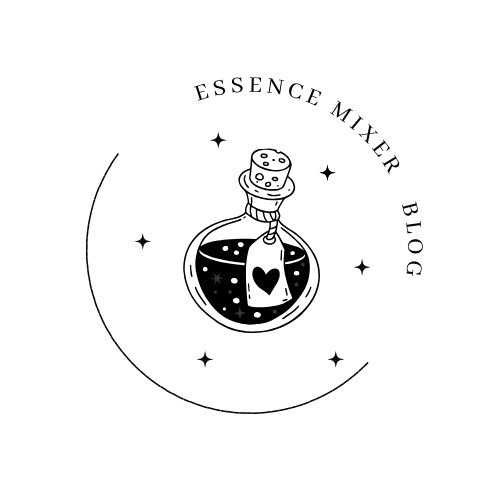
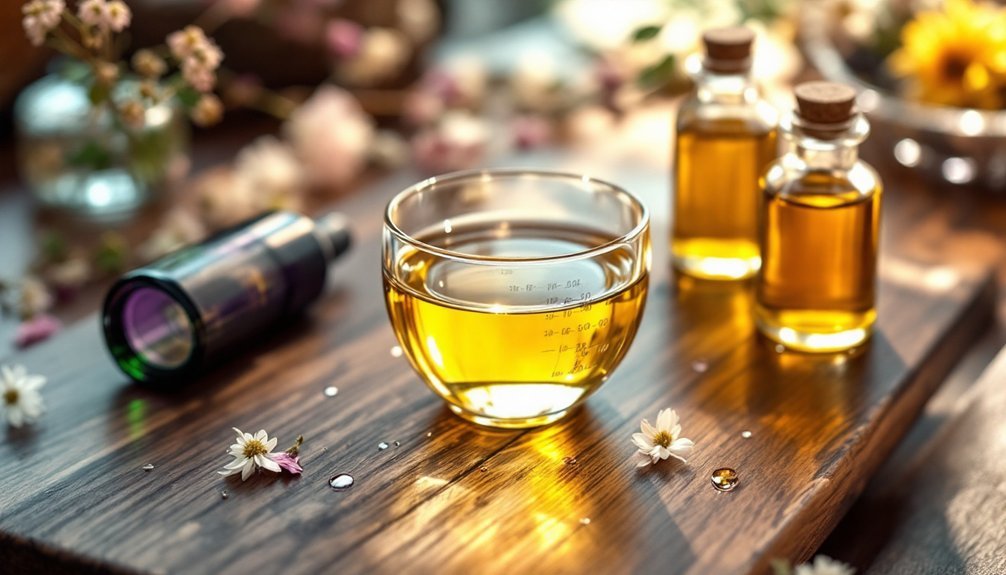


Leave a Reply